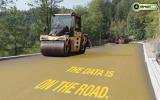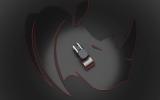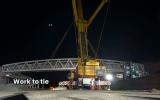
As vice president of Canadian barrier specialist QMB, based in Laval, Quebec, Marc-Andre Seguin is sanguine about the future for moveable barriers.
On the one hand, it looks good. The oft-stated advantage of moveable barriers is that the systems are cheaper to install than adding a lane or two to a highway or bridge. Directional changes to lanes can boost volume on a road without disrupting travel times – usually reducing them, in fact – for road users.
QMB’s
But on the other hand, the move towards autonomous, semi-autonomous and platooning vehicles could bring big changes to the design of roads including barriers, both fixed and moveable. These include crash strengths, barrier heights and overall dimensions. Are barrier manufacturers and purchasers of systems ready for the changes?
While the Zipper remains the “bread and butter”, he says, for the company, QMB distributes other barrier products, including crash cushions such as the Absorb 350, a narrow anchorless water-filled system, and the redirective non-gating TAU II, also from Lindsay.
In addition, QMB makes the Barrier Guard 800, a portable steel barrier for temporary or permanent locations. Importantly, QMB’s sister company
QMB is looking at the possibility of having the Zipper used on the planned Gordie Howe International Bridge. The six-lane 2.5km cable- stayed structure is a Canadian public-private partnership project over the Detroit River to connect Detroit in the US state of Michigan and Windsor in the Canadian province of Ontario. If the Zipper is used, it will be the first time that the system has been part of a bridge design and not an add-on, says Sequin. It would be a major step forward for mobility in general and should be the way of the future.
But the 40-year-old mechanical engineering graduate is also a realist. Not many people – even within the road sector - fully appreciate how artificial intelligence and the advent of autonomous vehicles will change road design, as well as use.
Connectivity, he says, will change everything. However, removing the driver is probably going to be the least important factor in the future of road use and design. The major impact will be in how autonomous vehicles ‘talk’ to each other and learn from the behaviour of other autonomous vehicles in an area through which all the connected vehicles are passing. Platooning of vehicles will have an incredible impact on road and bridge capacity, he believes.
If platooning autonomous vehicles drive at set distances to each other – closer than with a driver behind a wheel - then more cars can use the road. In practice, road and bridge capacities can be more accurately estimated and reached.
Two thing arise from this. The assumption is that there will be fewer accidents. If there are fewer accidents, then standards for road safety furniture can change, perhaps be lowered if vehicle speeds are also lower. Even the need for moveable barriers may be reduced, making the market much more competitive for major players and less attractive for new entrants.
At what point will this happen or at least be more apparent than today and force a shift in thinking about infrastructure? He believes “much sooner than, say, 2040”, as some analysts suggest. It will be game-changing for all in the road design and construction sector.
All aboard
The Zipper for the Louis Bisson Bridge sits in a shed in the middle of the permanent median just before the bridge. This particular US-made Zipper stands 3.4m high, 4.4m long and nearly 2.5m wide. Silent and sitting brooding-like in the shed, the 20.4tonne vehicle appears a brute of a beast.
And it is. Effective and efficient, yes. But no creature comforts here.
There is no suspension because the Zipper has to maintain an exact distance of chassis to the road surface to pick up the barrier and drop it down. The chassis can’t be allowed to float up and down, otherwise the elevated barrier could, as it passes under the Zipper, bottom out on the pavement. Only the two drivers’ seats have a suspension system which thankfully absorbs most of the jarring motion of the Zipper. The four tyres are foam-filled under pressure so there is little give there as well. Foam filling is also for added insurance against flats, a high-risk event because of the amount of debris that accumulates along the highway’s edge.
“We also pick up the garbage,” he says. As proof, along a wall of the shed hangs a row of passenger vehicle wheel covers, like big game hunting trophies. On the day that World Highways took a ride, the forward driver had to stop to pick up a metre-long steel bar that likely had been part of a truck’s suspension.
Following the Zipper is the crash truck, a standard commercial vehicle, with a large warning arrow on the rear. It slips in immediately behind the Zipper as the beast rumbles out of the shed area and into the lane next to the median on its way to the bridge to start picking up the barrier.
Louis Bisson Bridge
The seven-lane Louis Bisson Bridge opened in 1975 and spans the Rivière des Prairies between Montreal and Laval. It carries more than 150,000 vehicles/day as Quebec freeway Highway 13, including one reversible lane in the centre - an example of a permanent Zipper lane. The bridge was named after Canadian aviator Louis Bisson who flew for the UK’s Royal Air Force Ferry Command during World War II, making 138 crossings of the Atlantic Ocean.
Never too old
This particular Zipper was purchased some years ago from a maintenance contractor working on the old Tappan Zee Bridge in the US state of New York. Sequin figures the Zipper is likely around 20 or more years old – but not old, in fact, for a Zipper. It is in operation for only about two to three hours a day, and normally for no longer than 45 minutes in any outing.
Breakdowns occur but are extremely rare, thanks to a rigid regime of maintenance – babying the beast – back in the shed. In fact, the
The engine works hard, though, and maintains a steady RPM. There are no gears in the two-wheel-drive Zipper. A hydrostatic transmission handles the speed changes that range from 20-25kph in road mode as it drives to the pick-up point - the start of the barriers. It then moves ahead at a reduced 10kph, sluicing up the barrier.
Each individual barrier section is 1m long and there are 15m of connected barrier sections inside the machine at any one time.
The driver in the forward position steers the Zipper to scoop up the barriers – a chain consisting of individual barriers at 1m high by 610mm wide, weighing 650kg. The driver facing backwards at the rear steers to allow the Zipper to drop the barrier down in a straight line. Here lies the skill, says Sequin.
The rear-motion driver has to ensure a straight line and do so smoothly enough to not make it difficult for the forward-motion driver to steer the machine as it crawls forward to pick up the barrier. Above each driver is a small black and white video screen for a view of the road in front, or behind, of the other driver.
It’s as if the vehicle has two minds of its own, he explains, and the drivers coordinate their actions for a smooth and accurate ride.
The vehicle appears to crab along as the barrier catcher on the forward end scoops up the barrier, lifting it to around 10-15cm off the pavement and depositing it to one side of their original position.
The motion of the Zipper forces the slung barrier though a system that shifts it only to one side – not forward – and drops it down in a new position.
When the Zipper reaches the end of the barrier line, it reverses. In this way, what was the exit of the barrier is now the entrance as the Zipper travels back across the bridge, shifting the barrier again, to complete the lane change. The drivers’ jobs are now reversed.
When the Zipper approaches the end of the barrier line it must stop about 20m before the end. It doesn't physically turn around; it simply drives off in the opposite direction.
SwiftGate in action
However, first the crash truck will have moved out from behind the Zipper and headed down the road to the next interchange in order to come back in the opposite direction towards the Zipper. As it approaches the Zipper a series of SwiftGates, 35-50m apart, move out from the median to warn and force drivers out of the lane closest to the median.
Closing time
SwiftGate is a remotely controlled system that can include two types of modules: gate and signage. Gate modules consist of a pivoting gate, a solar panel and a control box. The high-density polyethylene gates are crash tested to NCHRP TL-3 requirements and accepted by the FHWA in the US.
Meanwhile, signage modules consist of a pivoting traffic sign, a solar panel and a control box. Both modules can be adapted with flashing lights and be installed on the right and/or the left side of the road.
Being solar powered, each system is independent of any wiring for ease of installation. When activated, the system creates a continuous obstacle line that acts as a vehicle deterrent more effective than regular delineation like barrels and cones, according to Versilis. The SwiftGate remote monitoring control is operated via an RF unit, cellular phone or a web-based application.
The latest version of the system is fully operational on Montreal’s Highway 13. Before installation of SwiftGates, maintenance crew had to manually close the lane to traffic four times a day to accommodate the Zipper. Lane opening and closing is now done remotely off-site.
It takes a special, even exceptional, person to drive a Zipper, says Sequin. “There is no telling who will make a good Zipper driver.”
Some are older and adapt well. Others are in their 20s and just can’t cope with the stress, noise and harsh environment. Often truck drivers are best at the job. They are used to sitting high off the ground and working heavy machinery in harsh and stressful situations, especially because of the constant buzz of vehicles – large trucks, cars and motorcycles passing on each side. “But even some truck drivers have a difficult time.”
Seguin and your correspondent were sitting at first in the rear-motion cab with driver Line Langlois, who, at the age of 49, has been with QMB for 24 years, mostly in the driver’s seat. It was Langlois who taught Seguin, who at 16 had only just passed his driving test for a road car - to drive a Zipper. All that is needed to drive a Zipper is a road licence.
“The worst are the motorcycles in the summer,” says Langlois. “Their sound is a high-pitched screech as they pass by. But you get used to it,” she says with a big smile.
The other driver, Camille Gauthier, is 65 and has been at the wheel for only five years. He loves it, he says. “ I used to be in sales in retail for years and was always standing around. This is much better, you have to always be so focussed on what you are doing and also be so calm. And continually be aware of the dangers.”
Like any road work, it is dangerous and always will be. “You can never get down to zero danger and risks,” says Sequin, back in the shed. “One of the most dangerous factors is not oncoming vehicles but driver complacency. As Camille says, you always have to be aware of the danger and 100% focussed on the job.”














